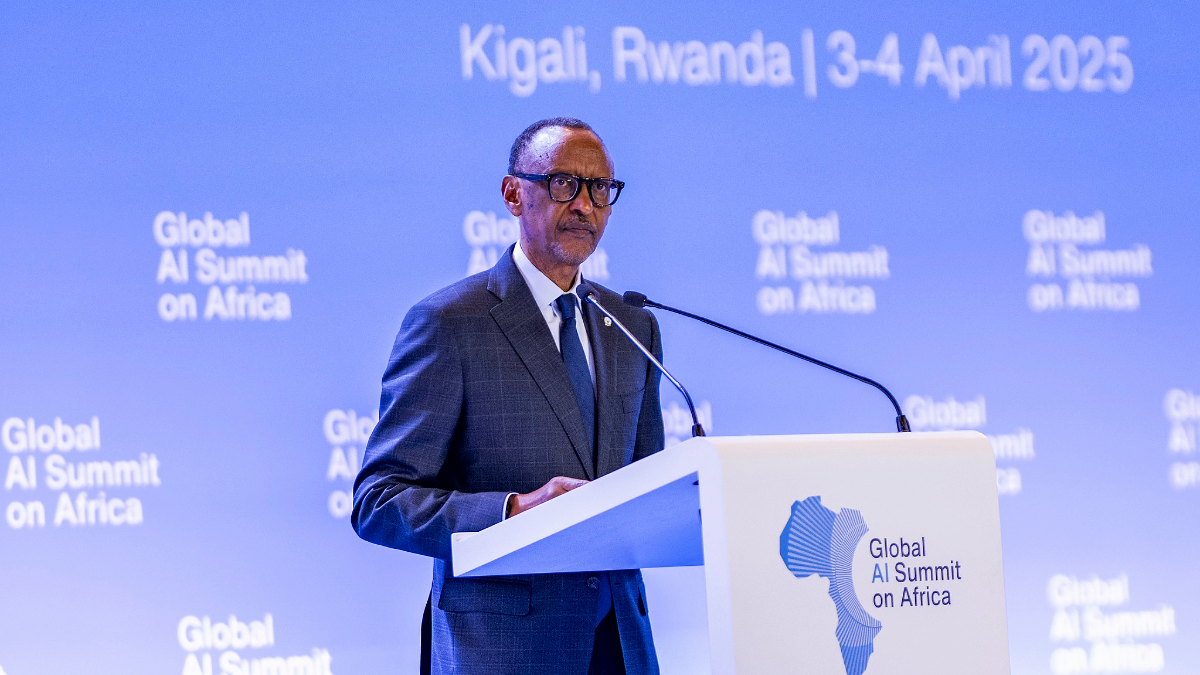AGI vs. AAI: Grassroots Ingenuity and Frugal Innovation Will Shape the Future
Akash Kapur / Jun 27, 2025
Rwandan President Paul Kagame addresses the Global AI Summit on Africa on April 3, 2025
Kigali in April had a hushed, concentrated atmosphere. The Rwandan capital was marking the thirty-first anniversary of the 1994 genocide, which killed nearly a million people in the country in just 100 days. Perhaps, too, the city’s hotels and conference venues were still recovering from a recent milestone that speaks to how far the country has traveled since that calamity.
Earlier that month, Kigali hosted the first Global AI Summit on Africa, drawing over 2,000 delegates from more than 90 countries to the domed Kigali Convention Center at the edge of town. It was a vivid showcase of pan-African digital cooperation and a demonstration of the potential for AI in the developing world.
The Summit further solidified Rwanda’s position as a leader in technology and tech policy on the African continent, and more broadly in the Global South. Following closely on the heels of the AI Summit in Paris, which identified global AI governance and inclusion as one of its key themes, and where India was a co-host, it also signaled growing interest in the role of AI outside the West. Even as excitement over AI continues to mount in the United States and the European Union, there are increasing questions over how the technology will play out in the rest of the world, as well as a certain amount of anxiety over whether it could widen existing global disparities.
The Kigali Summit yielded several outcomes that could potentially alleviate some of the anxieties. Among the Summit’s achievements were a commitment to establishing a $60 billion fund to help spread AI in Africa and the release of an Africa Declaration on Artificial Intelligence, endorsed by 54 signatories. But one of the most significant—if subtle and perhaps underappreciated—outcomes of the Summit was more tonal in nature, marked less by specific declarations than the articulation of an overall vision for AI in the Global South. This vision was apparent in repeated references at the Summit and its immediate aftermath to “use cases,” “AI solutions,” and “AI applications” (the latter was one of the Summit’s official thematic areas). During the Summit, policymakers announced the creation of a Rwanda Artificial Intelligence Scaling Hub, whose purpose is to identify and help deploy practical, real-world solutions, particularly in areas such as healthcare, agriculture, and education.
“African countries need to have clarity on what they want to do with AI,” said the Nigerian Communication Minister Bosun Tijani, one of many continental policymakers in attendance, likewise signaling a first-principles commitment to a more practical approach to AI. Only then, he added, should the continent turn to more conceptual concerns such as collaboration, digital sovereignty, and beyond.
Two AI paradigms
Step back from the day-to-day flurry surrounding AI, and a global divergence in narratives is becoming increasingly clear. In Silicon Valley, New York, and London, the conversation centers on the long-range pursuit of artificial general intelligence (AGI)—systems that might one day equal or surpass humans at almost everything. This is the moon-shot paradigm, fueled by multi-billion-dollar capital expenditure and almost metaphysical ambition.
In contrast, much of the Global South is converging on something more grounded: the search for near-term, proven use cases that can be deployed with today’s hardware, and limited budgets and bandwidth. Call it Applied AI, or AAI. This quest for applicability—and relevance—is more humble than AGI. Its yardstick for success is more measured, and certainly less existential. Rather than pose profound questions about the nature of consciousness and humanity, Applied AI asks questions like: Does the model fix a real-world problem? Can it run on patchy 4G, a mid-range GPU, or a refurbished phone? What new yield can it bring to farmers or fishermen, or which bureaucratic bottleneck can it cut?
One way to think of AAI is as intelligence that ships. Vernacular chatbots, offline crop-disease detectors, speech-to-text tools for courtrooms: examples of similar applications and products, tailored and designed for specific sectors, are growing fast. In Africa, PlantVillage Nuru helps Kenyan farmers diagnose crop diseases entirely offline; South-Africa-based Lelapa AI is training “small language models” for at least 13 African languages; and Nigeria’s EqualyzAI runs chatbots that are trained to provide Hausa and Yoruba translations for customers.
This emphasis on AI use cases is not restricted to Africa. Two of the biggest non-Western tech powers, India and China, are leaning in especially hard. Satya Nadella, CEO of Microsoft, and Nandan Nilekani, the co-founder of Infosys and a leading figure in the subcontinental tech policy landscape, have both recently stated that India could be the “use case capital of the world.” Many of these use cases are being embedded within the country’s burgeoning digital public infrastructure (DPI), which is used by over a billion people. China, too, has discovered both the strategic and practical virtues of AAI. “American firms focus on the model, but Chinese players emphasize practically applying AI,” Zhang Yaqin, a former president of Baidu, and before that an executive at Microsoft, recently told The Economist. The Economist also cites Xi Jinping’s exhortations to develop more AI use cases, and the Chinese President’s view that AI is apparently more akin to electricity (i.e., an enabling general-purpose technology) than nuclear weapons (the latter is a core conceit of Silicon Valley evangelists who believe AGI has existential ramifications).
What’s driving AAI?
If the search for AGI is reminiscent of a cash-rich unicorn aiming for growth at all costs, then AAI is more scrappy. Like a bootstrapped startup that requires immediate profitability, it prizes tangible impact over long-term ambitions to take over the world. The aspirations—and perhaps the algorithms themselves—may be more modest. Still, the context makes them potentially transformative: if reliable and widely adopted, such systems could reach millions of users who have until now been on the margins of the digital economy.
At least two forces, both constraints that may prove to be blessings, are driving the emergence of AAI. The most obvious is capital scarcity. The Financial Times notes that Amazon, Microsoft, Alphabet, and Meta, together, plan to spend around $320 billion on AI-related capital expenditures in 2025—more than the combined health spending of all 55 African Union member states. In 2024, more than $100 billion in venture capital was raised by generative AI startups, with the majority of these investments occurring in the United States. Such figures are out of reach for most countries and companies in the Global South.
The barriers are not just financial; technical constraints are also driving AAI. Frontier models are proprietary, GPU and data hungry, and frequently hard to customize for local languages and contexts. As a result, many Global South developers lean on open-source weights—think LLaMA derivatives fine-tuned for Kiswahili or Hindi—which are lighter, cheaper, and easier to adapt. These models may lag the most sophisticated frontier models by a benchmark or two, but part of the unstated premise of an AAI approach is that perhaps this doesn’t matter. Ethically, it may seem unfair if poorer countries are excluded from the most sophisticated models; practically, it may not make a significant difference. AAI is infused by a version of what the Indians call jugaad: frugal innovation, an emphasis on the practical over the flashy, and above all a laser-like focus on outcomes.
Lessons from AAI
The focus on use cases has its own potential shortcomings. Although lightweight, frugal, and tightly focused AI applications are now proliferating across the Global South, questions remain about actual adoption. There is concern, in other words, that the use cases may not have sufficient users. In addition, critics have suggested that the focus on use cases is little more than “hype” that instead serves a number of other agendas, such as a desire to enhance geopolitical stature.
These criticisms should be taken seriously. Still, a focus on more frugal, practical AI could help address a problem that has long plagued technical interventions in the Global South: they are often marked by skewed priorities, a misallocation of scarce resources, and the pursuit of grandiose, chimeric visions. In addition, it’s worth noting that concerns over use cases and applications are increasingly prevalent in the West, too. Even as billions continue to flow into the quest for AGI, there is mounting evidence about a slow uptake of AI (e.g., in businesses), and a certain amount of anxiety about a persistent “deployment gap.” As Mehdi Alhassani and Anthony Bak, both of Palantir, recently put it in the Wall Street Journal: “What will determine if a nation is ahead on AI isn’t if it has the best models first, but if it is translating AI into widespread benefits for society. This means bringing the best models into organizations’ core missions and processes.”
All this points to a potentially unexpected scenario, one in which the lessons of AI flow not along the usual contours of global geopolitics and economic power—but percolate rather upward, from the laboratories and pilot programs of the Global South toward the boardrooms and research campuses of the North. This doesn’t mean that the quest for AGI is necessarily misguided (though there are good arguments to that effect). It’s possible that AI may yet end up redefining intelligence. But meanwhile, what’s emerging is a complementary, arguably more urgent vision: one in which frontier innovation coexists with grassroots ingenuity, and in which the future of AI is shaped as much by constraint-driven creativity as by compute-intensive breakthroughs.
Authors
